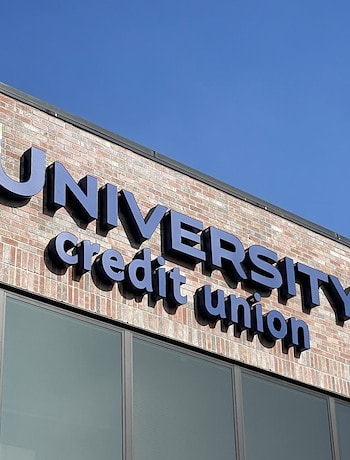
University Credit Union News
Stay informed about the latest University Credit Union initiatives, financial updates, new products and services, university partnerships, and more.
Whether you're seeking updates, news, or exciting product announcements, you can find the latest UCU-related news all in one place. We add new press releases and articles as they are published, ensuring our member-owners are always informed about newsworthy UCU events.
Catch up on the latest news from UCU
How a Budgeting Calendar Can Help You Reach Your Financial Goals
Read more about How a Budgeting Calendar Can Help You Reach Your Financial GoalsMerging Values: The Importance of Aligning Partnerships in Growth Strategies
Read more about Merging Values: The Importance of Aligning Partnerships in Growth StrategiesUCU and UTA Celebrate Partnership with Launch of Exclusive UTA-Branded Credit and Debit Cards
Read more about UCU and UTA Celebrate Partnership with Launch of Exclusive UTA-Branded Credit and Debit CardsTips From the Pros: Finding & Using the Right Student Card
Read more about Tips From the Pros: Finding & Using the Right Student CardExpert Insight on Student Loan Debt and Repayment
Read more about Expert Insight on Student Loan Debt and RepaymentPros and Cons of Credit Union Credit Cards
Read more about Pros and Cons of Credit Union Credit CardsHow Inflation Can Impact Your Loan Interest Rates
Read more about How Inflation Can Impact Your Loan Interest RatesListen: University Credit Union Saved $2M In 1 Year With AI-Powered Bot
Read more about Listen: University Credit Union Saved $2M In 1 Year With AI-Powered BotAol.com: 4 Ways To Redefine Your Relationship With Money
Read more about Aol.com: 4 Ways To Redefine Your Relationship With MoneyCUBroadcast: University Credit Union Eliminates Overdraft Fees to Promote Financial Inclusion
Read more about CUBroadcast: University Credit Union Eliminates Overdraft Fees to Promote Financial InclusionNerdwallet: 3 Business Loan Application Mistakes and How to Avoid Them
Read more about Nerdwallet: 3 Business Loan Application Mistakes and How to Avoid ThemUniversity Credit Union Eliminates Overdraft Fees, Says New Policy Will Promote 'Economic Inclusion'
Read more about University Credit Union Eliminates Overdraft Fees, Says New Policy Will Promote 'Economic Inclusion'Insights From A Doctor of Business Administration Degree Holder - CEO David Tuyo
Read more about Insights From A Doctor of Business Administration Degree Holder - CEO David TuyoCEO David Tuyo Discusses Mobile Banking Safety and Security at the SC Finance eConference
Read more about CEO David Tuyo Discusses Mobile Banking Safety and Security at the SC Finance eConferenceMoney and Finance Magazine Top Ten Finance Specialists 2021: Dr. David L Tuyo II
Read more about Money and Finance Magazine Top Ten Finance Specialists 2021: Dr. David L Tuyo IIMoneygeek Expert Insight: CEO David Tuyo on Managing Credit
Read more about Moneygeek Expert Insight: CEO David Tuyo on Managing CreditMoneygeek Expert Q&A: CEO David Tuyo on Short-Term Business Loans
Read more about Moneygeek Expert Q&A: CEO David Tuyo on Short-Term Business LoansCUbroadcast.com Podcast: Behind-the-Scenes Merger Talk with UCU's David Tuyo
Read more about CUbroadcast.com Podcast: Behind-the-Scenes Merger Talk with UCU's David TuyoCEO David Tuyo: How Multifaceted Leadership Drives the Best Results in the Credit Union Industry
Read more about CEO David Tuyo: How Multifaceted Leadership Drives the Best Results in the Credit Union IndustryChabot FCU to Merge Into University Credit Union
Read more about Chabot FCU to Merge Into University Credit UnionUniversity Credit Union Expands California Campus
Read more about University Credit Union Expands California CampusCredit Union Mergers & Acquisitions: Survival Strategy Or Path To Competitive Advantage?
Read more about Credit Union Mergers & Acquisitions: Survival Strategy Or Path To Competitive Advantage?FinTech Newscast Episode 154 - University Credit Union CEO Dr. David Tuyo
Read more about FinTech Newscast Episode 154 - University Credit Union CEO Dr. David TuyoWhat Is Mortgage Amortization and How Does It Work?
Read more about What Is Mortgage Amortization and How Does It Work?Fintech One-on-One Podcast 313: David Tuyo of University Credit Union
Read more about Fintech One-on-One Podcast 313: David Tuyo of University Credit UnionEmbrace the Mistakes: Interview with Dr. David Tuyo, CEO of University Credit Union
Read more about Embrace the Mistakes: Interview with Dr. David Tuyo, CEO of University Credit UnionMerger Activity Heats Up Among Local Credit Unions
Read more about Merger Activity Heats Up Among Local Credit UnionsPodcast: The Keys To Credit Union Success With Dr. David Tuyo Of UCU
Read more about Podcast: The Keys To Credit Union Success With Dr. David Tuyo Of UCUCEO David Tuyo Interview with CEOWORLD Magazine on Leadership
Read more about CEO David Tuyo Interview with CEOWORLD Magazine on LeadershipCEO David Tuyo Speaks About PPP Loans with Small Business Trends
Read more about CEO David Tuyo Speaks About PPP Loans with Small Business TrendsCEO David Tuyo Interview with Credit Union Times on Commercial Real Estate Lending
Read more about CEO David Tuyo Interview with Credit Union Times on Commercial Real Estate LendingCEO David Tuyo Interview on CUbroadcast.com
Read more about CEO David Tuyo Interview on CUbroadcast.comYou Can Refinance Personal Loans. Here’s When It Makes Sense and When It Doesn’t
Read more about You Can Refinance Personal Loans. Here’s When It Makes Sense and When It Doesn’tUniversity Credit Union press releases
Latest resources from University Credit Union
Calculators
UCU provides a broad range of financial resources for our member-owners, including calculators, guides, and helpful blog posts. Our educational modules can help you learn about budgeting, home loans, retirement, and more.
Learn more about Calculators Learning center
Our financial resources center includes plenty of easy-to-use, interactive, and dynamic learning tools to help you better manage your own money. Start learning today.
Learn more about Learning center Helpful forms
We're committed to convenience. Our forms make life easier and smarter for our member-owners.
Learn more about Helpful forms Giving our University Communities a financial advantage
University Credit Union offers membership to employees, students and alumni of UCLA, Pepperdine University, Loyola Marymount University, Santa Clara University, Saint Mary's College, UC Irvine, UC Davis, UC San Diego, Georgia Tech, University of Texas at Arlington, Abilene Christian University, Mount St. Mary's University, Chabot College and Las Positas College, West Coast Conference Universities, Western Athletic Conference Universities, and other universities throughout California. UCU offers a variety of products and services including checking accounts, credit cards, home mortgages, auto loans, personal loans, commercial loans, insurance, investments, as well as digital banking.
University Credit Union offers membership to employees, students and alumni of UCLA, Pepperdine University, Loyola Marymount University, Santa Clara University, Saint Mary's College, UC Irvine, UC Davis, UC San Diego, Georgia Tech, University of Texas at Arlington, Abilene Christian University, Mount St. Mary's University, Chabot College and Las Positas College, West Coast Conference Universities, Western Athletic Conference Universities, and other universities throughout California. UCU offers a variety of products and services including checking accounts, credit cards, home mortgages, auto loans, personal loans, commercial loans, insurance, investments, as well as digital banking.
Banking
Earn up to 5.00% APY* with a University Checking Account, save for your future goals with a savings account, or make your money work for you in a high-interest money market account.
Learn more about Banking Loans
Whether you need to finance a home, a vehicle, or a vacation, we're here for you- with our Best Rates in the Nation Guarantee*. Apply online today.
Learn more about Loans Find a location near you
You're covered from coast to coast with 30,000 surcharge free CO-OP ATMs and 5,000+ shared branches













